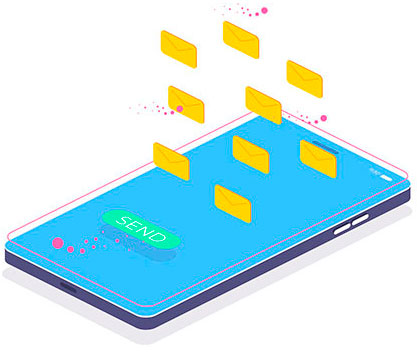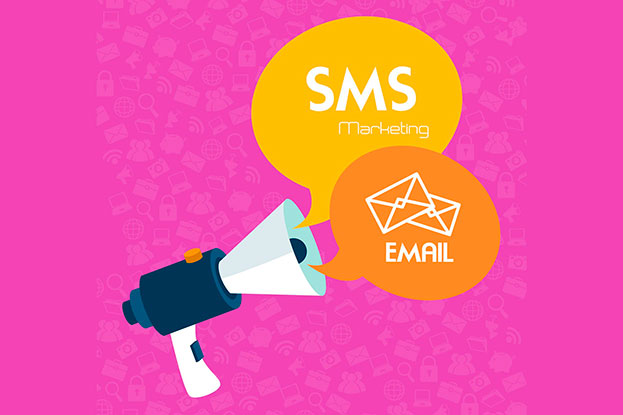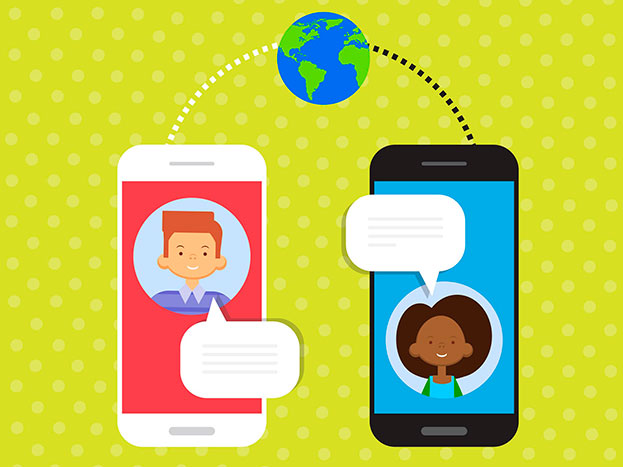SMS Marketing Guide for Business
The average person checks their phone once every twelve minutes.
I feel like twelve minutes is a conservative figure, I’m sure Millenials and gen-Zites check their phones more per minute than they breathe!
As unfortunate as this attack on our attention spans is, it has opened new avenues for marketers. Gone are the days of door-to-door selling, sending promotional letters (is paper still a real thing?) and advertising in print media; now, digital marketing is all the craze!
Of course, marketers were quick to realise this way before tailored advertisements started popping up in your inbox and on your Facebook feed… I am, of course, referring to the good old days of SMS marketing!
But, have the above-mentioned digital marketing methods made SMS marketing obsolete? Of course not, SMSes have an open rate of 95%, compared to just 24% for emails!
Besides, SMS marketing has become a surprisingly vacant field with marketers moving to social media, which means whoever makes it the “in” thing again gets the early bird advantage.
Interested? You should be! Confident? No? Lack the right knowledge and skills? Want to know about the nuances of SMS marketing? Well, fret not, that’s why I’m here, so without further ado, let’s get started!
Benefits of SMS Marketing
1. Reach
To drive the point home, allow me to present some cold, hard facts to you.
In 2019, approximately 81% of American adults own a smartphone. Seems like a lot, right? Well, contrast that statistic to this: 96% of American adults own a “cell-phone” of some kind.
Well, what does that mean? Simply put, 15% of the American population is not connected to the internet via a smartphone and has access only to basic SMS services, meaning the ads of marketers who focus solely on internet marketing don’t even reach them!
To put 15% into perspective, that’s approximately 52.5 MILLION people just waiting to receive your message! And these are over and above the smartphone owners, who are expected to receive your message anyway.
If we were to talk on a global scale, it gets even better. In 2019, an estimated 2.71 billion people own a smartphone. That’s a lot, right? Well, wait till you hear the fact that 5 billion people own a cell-phone of some kind. The implication? Approximately 2.29 BILLION people are left hung out to dry by internet marketers, and that’s where an SMS marketer steps in.
The conclusion here is that, contrary to popular belief, there’s a huge audience for SMS marketing and as an SMS marketer, filling that lacuna may prove to be very profitable.
The figures quoted above are authentic, collected by reliable sources and not apocryphal.

2. Coverage
While it is highly uncommon these days for people in urban jungles to experience even a second of no internet connectivity, residents of rural areas often have trouble connecting to the internet on their phones as most carrier corporations don’t see it commercially feasible to invest in upgrading the coverage of their networks in these areas.
That’s where SMS marketing steps in, because while these regions may not have internet connectivity, they do have basic cellular connectivity, and that’s all SMS needs to work.
Of course, those in rural areas are also less likely to own a smartphone, partly because they don’t see a need for it and partly because they know it’ll remain a very expensive brick in the absence of decent internet connectivity, therefore, advertising to these people via SMS makes sense.
3. Open and click-through rates
I’ve already mentioned this, so I’ll keep it short and sweet. SMS advertisements have spectacular open rates, about 95%, as mentioned, however, they also have an amazing click-through rate.
What’s a click-through rate? It’s the percentage of people who actually interact with the SMS once they’ve received it (provided it’s interactive). SMS advertisements have an average click-through rate of 36%.
Doesn’t sound like much? Compare that to a dismal 4-point-something percent click-through rate for email marketing, and you’ll realize that your audience is almost nine times more likely to follow through on an SMS advertisement than an email advertisement!

4. It’s surprisingly customizable
Gone are the days of pixelated letters on monochromatic Nokia displays, no, with the introduction of ‘rich’ text messages, and with Apple’s iOS leading the charge towards making SMSes as interactive and beautiful as social media messages, SMS has never been better.
This capability allows marketers to customize their campaign to any extent they desire and makes users more likely to interact with and ultimately, purchase your product.
However, use this capability with caution, because those running feature phones will not be able to interact with or even view rich-text messages, therefore, make sure your messaging lists are categorized region-wise.
5. Segregation of channels
SMS is a standalone channel, and most youngsters wouldn’t go so far as to call it “social media”, considering it an essential yet archaic method of communication, irrespective of the advancements SMS has made over the years.
But, is that necessarily a bad thing? While there is a business case to be made for intruding on people’s private virtual spheres (by advertising on social media) to market your product, it’s not very ethical or courteous, is it?
That’s where SMS marketing shines. As a standalone channel, nobody really minds SMS marketing, and they’re more likely to treat SMS as a dedicated domain of impersonal communication, which will work in your favour as your audience will see it as less of an annoyance.
6. SMS is incredibly powerful
SMS is no longer a bunch of characters, emojis and links haphazardly thrown together. In fact, several applications on the Play Store and the App Store utilize the power of SMS to further provide you relevant services.
Confused? Allow me to elaborate. I personally use this amazing app called ‘SMS Organizer’ by Microsoft. It categorizes all the texts I receive, segregates personal and impersonal communications and, after analyzing the promotional texts, recommends them to me at the opportune moment.
Still confused? Okay, for example, if you, a marketer, send me a text for a sale on your clothing brand, SMS Organizer will store it and when I’m near your store, it’ll notify me of the offer you sent me. Powerful? You bet! It also keeps track of my spending, my travel schedule, hotel, restaurant and movie bookings… the list is exhausting!
Okay, I’m sure you’re convinced that SMS is the way to go for business, now let’s look at how to go about SMS marketing.
7. It’s the Twitter of digital marketing
Okay, technically, Twitter is the Twitter of digital marketing (duh!) but since texts are restricted to 160 characters each (20 more than Twitter, I know), the scope for sending long-winded texts is limited and if you wish to exceed the limit, you’d incur a significant cost.
But, this begs the question, why would you want to exceed the limit? As I’ve mentioned before, the attention spans of people these days are comparable to a goldfish’s, so getting your point across in less characters makes sense.
One-liners, abbreviations, acronyms, etc. can be used to great effect when marketing via SMS and will prevent your text from becoming protracted and banal.

How Do I Make My SMS Marketing Campaign Effective?
Before I let you in on my secrets of SMS marketing, we need to lay down some ground rules that you absolutely cannot break, not only while engaging in SMS marketing but also while engaging in marketing of any sort.
Remember, marketing is more than advertising or selling or a combination of stuff like this. Marketing is a catch-all term that is also greater than the sum of its parts, and the primary purpose of marketing is to fill a need and do so profitably.
Therefore, a good marketer identifies a need in the market, identifies who needs something, what it is they need, when they need it, at what price point they need it, etc. And then tries to fulfil the need as efficiently, as effectively and most importantly, as profitably as possible.
The same rules apply to SMS marketing. When sending out your texts, make sure that there is a rhyme and reason to them, that they are being sent at just the right moment and to the right people.
Of course, 100% accuracy is neither required nor possible, so you should try your best.
Preaching done, let me give you some concrete tips!
1. Get clear
The first step is to get clarity, and the best way to do that is to ask yourself questions.
What am I marketing? Why am I marketing this? Who am I marketing this to? And so on. You can start by answering the first question; some things that are usually marketed or communicated via SMS are:
New goods
New services
Sales and offers
Notifications
Delivery updates
Appointment reminders
Important news
Support
Once you have identified what it is you’re conveying via text, you can tailor the text accordingly, keeping in mind the target audience. Who are you marketing to?
If you are, say, SMSing senior citizens, make sure the message is well-punctuated, devoid of slang and modern jargon and gets directly to the point. Conversely, if you’re marketing to a younger demographic, some well-placed slangs, jargon and TLAs will make the message infinitely more attractive.
This has been but one example of how getting clarity and adapting your strategy by questioning it (even if those questions get harsh at times) works, and in this rapidly changing world, adapting is crucial to survival.
2. Keyword and shortcode
The keyword and the shortcode are two of the most important components of SMS marketing.
What is the keyword? In the kind of interactive text where the lead has to reply with a specific word or phrase, that word or phrase is called the keyword.
What is the shortcode? Well, a large portion of SMS marketers use the sort of services wherein replies are not supported by the sender which sent the promotional text, so you might have to send the keyword (explained above) to a specific number.
This number won’t be anything like a normal number, it’ll have some sort of pattern (though that’s not necessary) to make it easy to remember and it’s usually pretty short, around five digits, which is why it’s called a shortcode.
Why is it important to have a keyword and a shortcode? Firstly, a keyword is precise; the intention of the sender is clear. Secondly, a shortcode is easy to type and remember. Thirdly, it prevents digital clutter from accumulating. Lastly, several keywords can be used on the same shortcode for different actions.
3. Get personal
No, I’m not telling you to pick a fight with the lead, no, to the contrary, make your message as personal as possible so that it appeals to the lead.
How do you make your message personal? It’s actually very simple. Don’t make your message sound like it was written by a robot, a human that functions like a robot or a person who couldn’t be bothered to care.
One very effective method of going about this is to include tons of pronouns. Do not call the lead a “customer”, “lead” or something of the sort, because that’s borderline derogatory! Instead, use “we”, “I”, “you”, “us”, etc.
Why should make your message personal? What’s wrong with an impersonal message? An impersonal message is incredibly run-of-the-mill and reeks of cold-selling, and nobody wants to hear borderline corporate-speak.
Instead, when you make your message personal, you make the lead feel like they deserve your attention and that they are being attended to as well. It can also alleviate bad moods, such as blues, as it gives off a feeling of warmth.

4. Don’t beat around the bush
SMS marketing is an art, and like an effective speech, rhetoric and fillers have to be carefully employed. However, since attention spans are short, character count is limited and people are generally time-starved, it’s best to send out a crisp and clear message.
The best way of doing so is to include a CTA, or a call-to-action, which is usually a prompt directing the lead to follow through, usually by clicking a hyperlink. Most leads are likely to skim through the message instead of reading it thoroughly, so in case they’re interested, they should have a way of following-through at their tips.
5. Take time-zones into account
The U.S.A. itself has six time-zones, and the world has twenty-four in total, and you don’t want to annoy your lead by waking them up from their slumber at 2 am, do you?
Taking time-zones into account can be immensely beneficial, for example, if you’re advertising an offer or a promotional scheme for, say, a clothes line, do so after lunch-time, since people tend to be more generous on a full stomach. Similarly, something austere like an insurance scheme is better advertised in the morning on a weekday.
6. Cultivate and grow the relationship
SMS marketing is great for initiating relationships, however, most marketers make the fatal mistake of not cultivating and growing the relationship, which makes the lead feel alienated from your campaign.
Refer to previous exchanges, send out person-specific offers and some well-timed follow-up messages, such as feedback forms, go a long way towards making leads feel part of the brand.
Beware, however, of going overboard, as too many messages will lead to your campaign being perceived as annoying and intrusive.
7. Make the message interactive
I’ve mentioned this previously, so I’ll keep this short. Nobody likes to hear a monologue, but everybody loves a dialogue, therefore, make the message as interactive as possible.
While the scope for interaction in SMS is not as high as, say, a message sent via social media, they can still be made pretty interactive. The first and foremost element that will make your message more interactive is a hyperlink, covered previously when I talk about CTAs.
Another efficient way of making your texts more interactive is to send questionnaires powered by the servers.
For example, you could ask a lead, “Feeling the heat this season? Interested in buying an air-conditioner @ 50% off? Y/N.” The interactive nature of the SMS paired with an irresistible offer makes the lead very likely to at least interact with the text, if not purchase the product.
If, somehow, you were able to identify those using iOS devices, you could include animated gifs or emojis whatever new-fangled technology the kids are using on SMS these days!

8. Shorten your links
While shortening your links is a standard best practice, you’d be surprised at how many people simply forget or don’t know that they should do it.
Instead of sending out a protracted link that usurps precious characters and makes the SMS ugly, you could use a link-shortening service to preserve space and make the message attractive.
9. Offer SMS-only incentives
While I’m a little hazy on the current legal position, to the best of my knowledge, the government mandates SMS marketers to send a consent text prior to beginning their marketing, meaning the lead has to explicitly consent to receiving your messages.
The silver lining to this cloud is that those who consent to receiving your messages are actually interested in them, and it’s only fair to reward their enthusiasm, right? Right!
That’s why it’s advisable for you to offer to leads who are loyal to your SMS marketing campaign some exclusive incentives. You could, for instance, if you run a digital store, send a coupon code exclusively to your SMS-minions, boosting their loyalty and your audience.
10. Automate your campaign
You could work very hard to reach the top. You could choose to bury your head in the sand like an ostrich and remain oblivious to the technological advancements. You could sacrifice leisure for doing something which a machine can do without getting tired.
See what I mean? Work hard, but more importantly, work smart.
The way to incorporate that into your SMS marketing campaign is by automating your campaign. Once you have the data of your leads, segregate them on whatever basis you wish to. I usually have three groups, i.e., based on age group, based on time-zone and based on loyalty. You can create your own lists and groups.
Next, software like Zapier can make the process even simpler for you, as it will combine with most social media platforms, such as Facebook, and extract lead information from there as well, combining it with the information you’ve already gathered.
Things to Look Out For
You should keep the following in mind while preparing your campaign.
1. Legality
As mentioned above, my knowledge of the laws surrounding the area is sketchy, so it’s best to do your own research or consult a lawyer (I have hired one for peace of mind). It’s best to do this as any violation may lead to hefty penalties.
2. Sensitivities
It is very important to not touch any nerves. Keep your messages as neutral and as politically correct as possible. Don’t make them boring, but don’t make them obscene either. After all, you’re not on primetime, are you?
3. Honoring the deal
You shouldn’t, even by accident, put out something that you don’t intend on honoring. So, an offer for 50% discount on your product must be honored, otherwise it’ll lead to a tarnished reputation and might invite legal trouble.
Conclusion
SMS marketing has been wrongly assumed to be obsolete, with open rates and follow-through rates putting “traditional” marketing methods like email marketing and social media marketing to shame.
As it is slightly different, it is important to appreciate the nuances of SMS marketing. This guide contains almost everything you’ll need on your journey of SMS marketing, and the tips contained herein should see plenty of leads converted into customers.
Happy marketing!